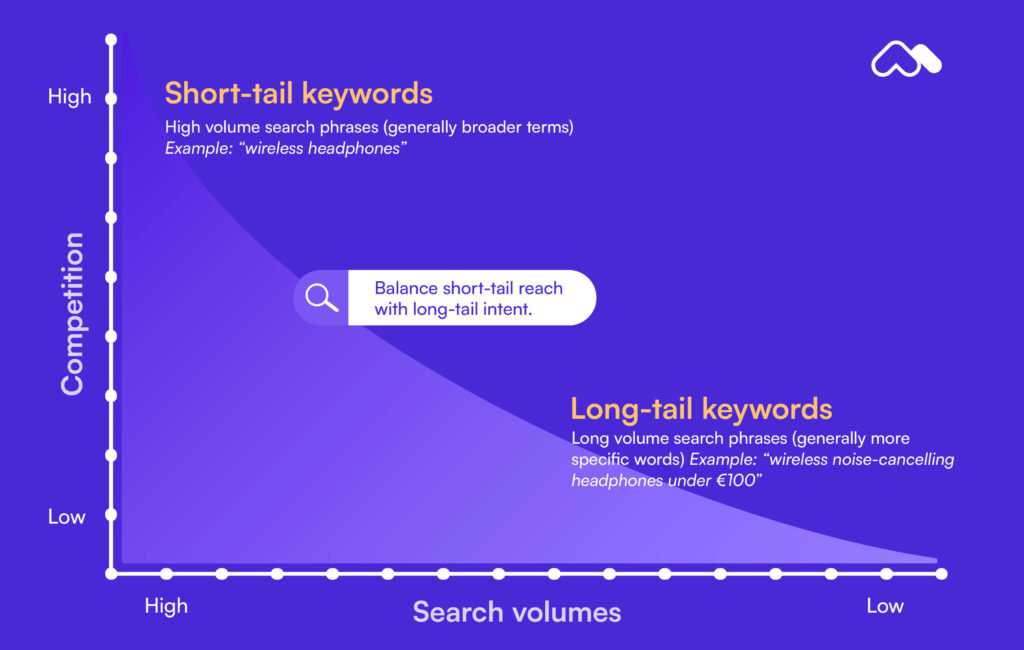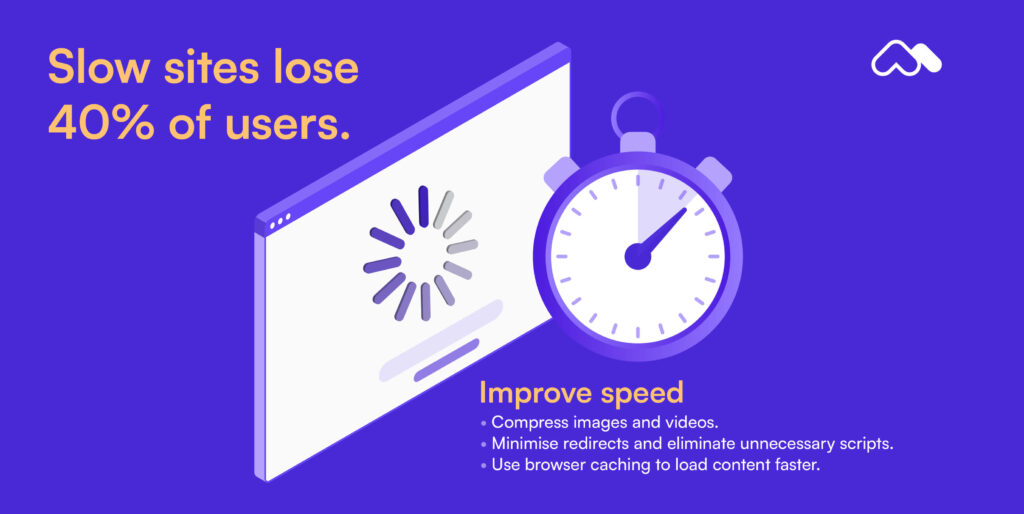If you’ve ever typed “cast-iron frying pan” or “best waterproof hiking boots” into Google, you’ve demonstrated the power of high-intent search. People turn to search engines when they’re ready to solve a problem or buy a product. For ecommerce businesses, appearing at the top of those results is game-changing.
Search engine optimisation (SEO) is how you get there. It’s a long-term strategy that improves your site’s visibility for searches like these. Unlike paid ads, SEO doesn’t offer instant gratification. It takes months, sometimes more, to see results. But once you do the hard work upfront, the payoff is continuous.
SEO is crucial to ecommerce success because search is where most journeys start:
- 49% of shoppers use Google to discover new products.
- The top three results on Google capture 54% of clicks, meaning visibility translates directly into potential sales.
If you’re not ranking high, you’re losing out to competitors.
Why does ranking matter so much? It’s about getting your store in front of people who are already looking for what you sell. These searchers are primed to purchase. Whether it’s “sustainable gym leggings” or “wireless headphones under €100,” they are closer to buying than anyone scrolling on social media.
Organic search accounts for 53% of website traffic across industries, more than any other channel. For ecommerce businesses, this means SEO delivers customers without the recurring spend of paid ads. It’s also a cost-effective way to maintain steady traffic.
SEO success doesn’t happen overnight. But by laying the groundwork now, you can attract high-intent shoppers, increase your visibility, and build sustainable growth for the future.
Getting started with ecommerce SEO
Before you can optimise your ecommerce site, you need to know what your customers are searching for. That’s where keyword research comes in. Keywords are the foundation of any SEO strategy, helping you connect with the right audience at the right time.
Choosing the right keywords means understanding what shoppers are typing into Google. A broad, high-volume term like “wireless headphones” will attract a lot of competition. A more specific phrase such as “wireless noise-cancelling headphones under €100” is a long-tail keyword. It has lower search volume but higher purchase intent, which is what ecommerce businesses need.
Start by identifying keywords for:
- Category pages: Broad, high-volume terms that describe product groups, like “men’s running shoes.”
- Product pages: More specific, often branded terms, such as “Nike Air Zoom Pegasus.”
Tools like Google Keyword Planner, Ahrefs, and Ubersuggest can help you find the right mix of keywords. Look for terms that combine strong search demand with realistic competition levels. Strike a balance between short-tail keywords that bring visibility and long-tail ones that drive conversions.

Site structure and navigation
Once you know your keywords, you need a website structure that makes it easy for both shoppers and search engines to find your pages. Intuitive site navigation reduces friction for visitors and ensures Google can index your site efficiently.
A well-organised ecommerce site typically looks like this:
Homepage > Category pages > Subcategory pages > Product pages
Every click should feel logical and effortless for the user. If visitors can find what they need quickly, they’re more likely to convert. Breadcrumb trails, which show a clear path back to previous pages, improve both navigation and SEO. They also help Google understand your site’s hierarchy.
Clean, descriptive URLs are equally important. For example:
- Good: yoursite.com/headphones/wireless
- Bad: yoursite.com/category123/?id=4567
Optimising for mobile users
Mobile accounts for over 60% of online traffic. If your site isn’t optimised for mobile users, you’re missing out. Shoppers want fast load times, clean navigation, and responsive designs that work seamlessly on smaller screens.
Here’s how to improve mobile SEO:
- Use simple, collapsible menus for easy navigation.
- Optimise images and compress files to improve load speed.
- Avoid intrusive pop-ups that frustrate users on mobile devices.
Google prioritises mobile-friendly websites in its rankings. A responsive, mobile-first design isn’t just good for user experience; it’s essential for SEO success.
Optimising your ecommerce site for search engines
To stand out in search results and attract ready-to-buy customers, your ecommerce site needs a mix of on-page, technical, and content-driven SEO. Here’s how to maximise visibility and performance.
On-page SEO
Every page on your ecommerce site is an opportunity to rank and convert. Start with compelling product descriptions. These should be unique, descriptive, and tailored to customer needs. Instead of generic text, focus on benefits and key details that answer shopper questions. For example:
- “Our cast-iron frying pan is pre-seasoned for immediate use and retains heat for perfect searing. Oven-safe and built to last.”
Avoid keyword stuffing, but naturally incorporate relevant search terms to help search engines understand the content.
Your meta titles and descriptions are equally important. Titles should include target keywords and stay under 60 characters. Descriptions should be under 160 characters, highlighting why someone should click. A strong meta description can significantly improve click-through rates.
Image optimisation is another must. Use descriptive file names like “cast-iron-frying-pan.jpg” instead of “IMG_1234.jpg”. Add alt text to describe images for both search engines and users with screen readers. Compress files to reduce page load times without compromising quality.
Technical SEO
Technical SEO ensures search engines can crawl and index your site effectively. Start by improving site speed. Research shows that 40% of users abandon pages that take more than three seconds to load. To speed things up:
• Compress images and videos.
• Minimise redirects and eliminate unnecessary scripts.
• Use browser caching to load content faster.
Avoid duplicate content at all costs. This is a common issue for ecommerce sites, especially when product pages are duplicated across categories. Use canonical tags to tell search engines which version of a page to prioritise.
Schema markup is another powerful tool. Adding structured data helps Google display rich snippets, such as star ratings, prices, and stock availability, directly in search results. Rich snippets improve visibility and click-through rates, making your products stand out.
Implementing HTTPS connections is non-negotiable. HTTPS not only protects customer data but is also a ranking factor for Google. If your site isn’t secure, you risk losing both trust and rankings.

Content marketing
Quality content is the secret weapon of ecommerce SEO. Blogs, FAQs, and product guides allow you to target informational keywords that customers search before making a purchase. For example, a blog on “How to season a cast-iron frying pan” can attract users who are likely to buy one.
Here’s why content matters:
- It builds authority and trust.
- It answers questions and improves user experience.
- It allows you to internally link to product and category pages.
Don’t overlook customer reviews and user-generated content (UGC). Reviews increase trust and provide fresh content that search engines value. Encourage customers to leave detailed reviews and share photos of your products in action.
Building backlinks and authority
Building backlinks is a cornerstone of ecommerce SEO. Quality backlinks signal to search engines that your site is trustworthy and relevant, helping to improve rankings and drive organic traffic. For ecommerce sites, earning these links can be more challenging, but there are proven strategies to make it work.
Here are practical ways to earn backlinks:
- Guest blogging: Share insights and expertise on industry-relevant websites, including links back to your store.
- Engage with influencers: Partner with influencers in your niche to feature or review your products, as their content often attracts organic shares and links.
- Encourage social sharing and PR campaigns: Use press releases, collaborations, and shareable content like guides, videos, or infographics to gain attention and valuable backlinks.
Focus on value-driven outreach, and you’ll build long-term authority that strengthens your SEO performance.
Measuring and refining your SEO efforts
To maximise the success of your ecommerce SEO, you need to measure and refine your strategies regularly.
- Tools like Google Analytics and Google Search Console provide valuable insights into site performance.
- Track key metrics such as bounce rates, time on page, and conversion rates to understand what’s working and where you can improve.
- Keep a close eye on search engine algorithm updates, as they can impact your rankings.
- Continuous optimisation ensures your site stays aligned with evolving SEO requirements and customer search behaviour.
SEO is not a one-and-done task. It’s an ongoing investment that delivers substantial long-term returns. By building a strong foundation and maintaining consistent efforts, you create a sustainable source of organic traffic that drives visibility and sales. Now is the time to invest in SEO for your ecommerce business. Explore how Montonio can further enhance your operations with seamless payment solutions that increase conversions and provide an excellent customer experience.
